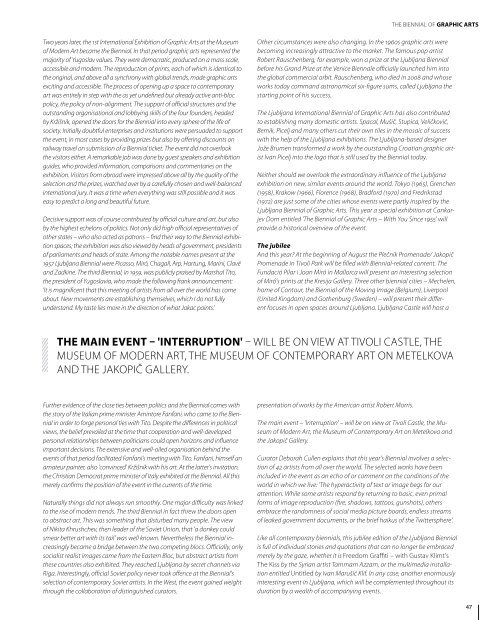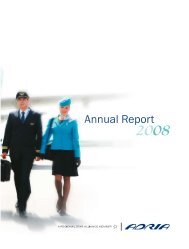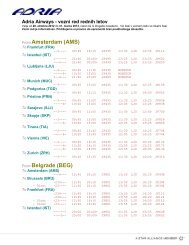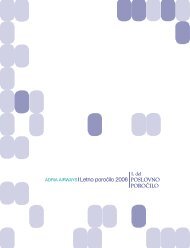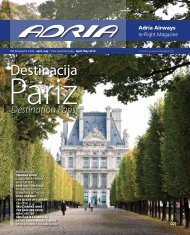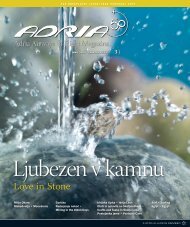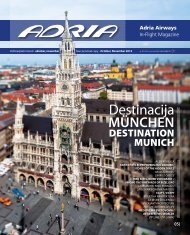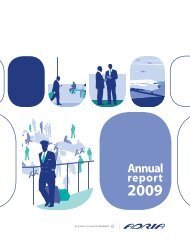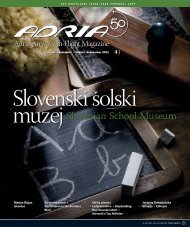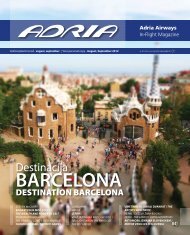København - Adria Airways
København - Adria Airways
København - Adria Airways
Create successful ePaper yourself
Turn your PDF publications into a flip-book with our unique Google optimized e-Paper software.
the biennial of graphic artsTwo years later, the 1st International Exhibition of Graphic Arts at the Museumof Modern Art became the Biennial. In that period graphic arts represented themajority of Yugoslav values. They were democratic, produced on a mass scale,accessible and modern. The reproduction of prints, each of which is identical tothe original, and above all a synchrony with global trends, made graphic artsexciting and accessible. The process of opening up a space to contemporaryart was entirely in step with the as yet undefined but already active anti-blocpolicy, the policy of non-alignment. The support of official structures and theoutstanding organisational and lobbying skills of the four founders, headedby Kržišnik, opened the doors for the Biennial into every sphere of the life ofsociety. Initially doubtful enterprises and institutions were persuaded to supportthe event, in most cases by providing prizes but also by offering discounts onrailway travel on submission of a Biennial ticket. The event did not overlookthe visitors either. A remarkable job was done by guest speakers and exhibitionguides, who provided information, comparisons and commentaries on theexhibition. Visitors from abroad were impressed above all by the quality of theselection and the prizes, watched over by a carefully chosen and well-balancedinternational jury. It was a time when everything was still possible and it waseasy to predict a long and beautiful future.Decisive support was of course contributed by official culture and art, but alsoby the highest echelons of politics. Not only did high official representatives ofother states – who also acted as patrons – find their way to the Biennial exhibitionspaces; the exhibition was also viewed by heads of government, presidentsof parliaments and heads of state. Among the notable names present at the1957 Ljubljana Biennial were Picasso, Miró, Chagall, Arp, Hartung, Marini, Clavéand Zadkine. The third Biennial, in 1959, was publicly praised by Marshal Tito,the president of Yugoslavia, who made the following frank announcement:'It is magnificent that this meeting of artists from all over the world has comeabout. New movements are establishing themselves, which I do not fullyunderstand. My taste lies more in the direction of what Jakac paints.'Other circumstances were also changing. In the 1960s graphic arts werebecoming increasingly attractive to the market. The famous pop artistRobert Rauschenberg, for example, won a prize at the Ljubljana Biennialbefore his Grand Prize at the Venice Biennale officially launched him intothe global commercial orbit. Rauschenberg, who died in 2008 and whoseworks today command astronomical six-figure sums, called Ljubljana thestarting point of his success.The Ljubljana International Biennial of Graphic Arts has also contributedto establishing many domestic artists. Spacal, Mušič, Stupica, Veličković,Bernik, Picelj and many others cut their own tiles in the mosaic of successwith the help of the Ljubljana exhibitions. The Ljubljana-based designerJože Brumen transformed a work by the outstanding Croatian graphic artistIvan Picelj into the logo that is still used by the Biennial today.Neither should we overlook the extraordinary influence of the Ljubljanaexhibition on new, similar events around the world. Tokyo (1965), Grenchen(1958), Krakow (1966), Florence (1968), Bradford (1970) and Fredrikstad(1972) are just some of the cities whose events were partly inspired by theLjubljana Biennial of Graphic Arts. This year a special exhibition at CankarjevDom entitled 'The Biennial of Graphic Arts – With You Since 1955' willprovide a historical overview of the event.The jubileeAnd this year? At the beginning of August the Plečnik Promenade/ JakopičPromenade in Tivoli Park will be filled with Biennial-related content. TheFundació Pilar i Joan Miró in Mallorca will present an interesting selectionof Miró's prints at the Kresija Gallery. Three other biennial cities – Mechelen,home of Contour, the Biennial of the Moving Image (Belgium), Liverpool(United Kingdom) and Gothenburg (Sweden) – will present their differentfocuses in open spaces around Ljubljana. Ljubljana Castle will host aThe main event – 'Interruption' – will be on view at Tivoli Castle, theMuseum of Modern Art, the Museum of Contemporary Art on Metelkovaand the Jakopič Gallery.Further evidence of the close ties between politics and the Biennial comes withthe story of the Italian prime minister Amintore Fanfani, who came to the Biennialin order to forge personal ties with Tito. Despite the differences in politicalviews, the belief prevailed at the time that cooperation and well-developedpersonal relationships between politicians could open horizons and influenceimportant decisions. The extensive and well-oiled organisation behind theevents of that period facilitated Fanfani's meeting with Tito. Fanfani, himself anamateur painter, also 'convinced' Kržišnik with his art. At the latter's invitation,the Christian Democrat prime minister of Italy exhibited at the Biennial. All thismerely confirms the position of the event in the currents of the time.Naturally things did not always run smoothly. One major difficulty was linkedto the rise of modern trends. The third Biennial in fact threw the doors opento abstract art. This was something that disturbed many people. The viewof Nikita Khrushchev, then leader of the Soviet Union, that 'a donkey couldsmear better art with its tail' was well known. Nevertheless the Biennial increasinglybecame a bridge between the two competing blocs. Officially, onlysocialist realist images came from the Eastern Bloc, but abstract artists fromthese countries also exhibited. They reached Ljubljana by secret channels viaRiga. Interestingly, official Soviet policy never took offence at the Biennial'sselection of contemporary Soviet artists. In the West, the event gained weightthrough the collaboration of distinguished curators.presentation of works by the American artist Robert Morris.The main event – 'Interruption' – will be on view at Tivoli Castle, the Museumof Modern Art, the Museum of Contemporary Art on Metelkova andthe Jakopič Gallery.Curator Deborah Cullen explains that this year's Biennial involves a selectionof 42 artists from all over the world. The selected works have beenincluded in the event as an echo of or comment on the conditions of theworld in which we live: 'The hyperactivity of text or image begs for ourattention. While some artists respond by returning to basic, even primalforms of image reproduction (fire, shadows, tattoos, gunshots), othersembrace the randomness of social media picture boards, endless streamsof leaked government documents, or the brief haikus of the Twittersphere'.Like all contemporary biennials, this jubilee edition of the Ljubljana Biennialis full of individual stories and quotations that can no longer be embracedmerely by the gaze, whether it is Freedom Graffiti – with Gustav Klimt'sThe Kiss by the Syrian artist Tammam Azzam, or the multimedia installationentitled Untitled by Ivan Marušić Klif. In any case, another enormouslyinteresting event in Ljubljana, which will be complemented throughout itsduration by a wealth of accompanying events.47


